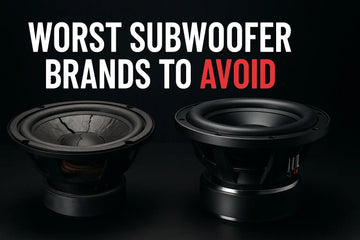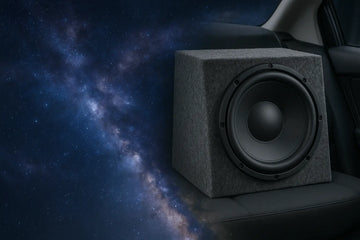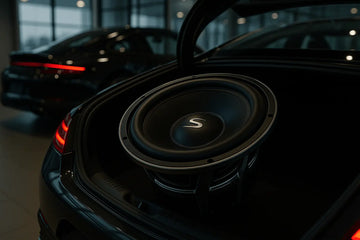When it comes to car audio systems, choosing the wrong subwoofer can turn your dream setup into a nightmare. Poor quality subwoofers and speakers don’t just deliver disappointing sound quality—they can fail catastrophically, sometimes within minutes of installation. With countless brands flooding the market, knowing which ones to avoid can save you time, money, and frustration.
The audio industry has seen a surge in budget subwoofer brands that prioritize low prices over performance and reliability. Brands like Pyle are often associated with low-cost, low-quality products and are frequently listed among those to avoid for serious audio enthusiasts. These companies often use deceptive marketing tactics, inflated specifications, and cheap materials to create products that look appealing on paper but fail miserably in real-world applications. Understanding which brands consistently produce substandard products is essential for anyone serious about their car audio system.
This comprehensive guide will help you identify the worst subwoofer brands currently on the market, understand why they fail, and point you toward better alternatives. We’ll examine specific brands, analyze their common problems, and provide you with the knowledge needed to make informed decisions when shopping for subwoofers.
The Worst Subwoofer Brands to Avoid in 2025
Several brands have consistently earned their place on the “stay away” list among car audio enthusiasts and professionals. These worst subwoofer brands include Pyramid Car Audio, Dual Audio, Planet Audio, Zed Audio, and Boss Audio Systems. Each of these companies has built a reputation for producing subwoofers and other related stuff—like speakers and amplifiers—that suffer from fundamental design flaws, poor materials, and unreliable performance.

The primary issues plaguing these brands include the use of cheap materials like thin paper cones, undersized magnets, and poorly constructed voice coils. These subwoofers typically feature exaggerated power ratings that bear little resemblance to their actual capabilities. Many users report failures within hours or even minutes of use, with common problems including blown voice coils, cone separation, and complete thermal shutdown.
What makes these brands particularly problematic is their widespread availability and aggressive pricing. They’re often sold through major retailers and online marketplaces, with a focus on selling large volumes rather than quality or customer satisfaction. This makes them easily accessible to unsuspecting consumers who assume that any subwoofer is better than none. However, investing in these products often results in poor sound quality, frequent replacements, and potential damage to amplifiers and other car audio gear.
Pyramid Car Audio: Mass-Produced Disappointment
Pyramid Car Audio has become synonymous with low-quality car audio products, particularly their subwoofers. The company’s approach to manufacturing involves mass production with minimal quality control, resulting in products that vary wildly in performance even within the same product line. Their 12-inch subwoofers, often priced aggressively low, exemplify everything wrong with budget car audio.
The construction quality of Pyramid subwoofers reveals numerous cost-cutting measures that directly impact performance and longevity. Their cones are typically made from thin, untreated paper that lacks the rigidity needed for accurate bass reproduction. The voice coils are often undersized and poorly cooled, leading to rapid thermal failure under even moderate power loads. Many users report that Pyramid subs develop a distinctive “burnt” smell within minutes of operation—a clear sign of voice coil overheating.
Pyramid’s broad product range, spanning from tiny 6-inch subs to massive 15-inch models, demonstrates their focus on market coverage rather than engineering excellence. This shotgun approach to product development means that resources that could be spent on research and development are instead spread thin across dozens of mediocre designs. The result is a catalog full of subwoofers that fail to excel in any particular application.
Real-world examples of Pyramid failures are abundant in car audio forums and review sites. Users frequently report complete failure within the first day of use, with many describing scenarios where the subwoofer simply stopped working during normal listening sessions. The company’s customer service has also received criticism for being difficult to reach and unhelpful when dealing with warranty claims.
Dual Audio: Global Reach, Local Problems
Dual Audio has achieved significant market penetration through aggressive pricing and wide distribution, but their success in sales doesn’t translate to success in performance. The brand’s mass production approach prioritizes quantity over quality, resulting in subwoofers that consistently underperform and fail prematurely. Their global reach means these problematic products have disappointed car audio enthusiasts worldwide.
One of the most commonly reported issues with Dual subwoofers is overheating. Their amplifiers and subwoofers alike suffer from inadequate thermal management, with insufficient heat sinks and poor ventilation design. This problem is compounded by the use of low-quality components that generate excessive heat during operation. Many users report that Dual products become uncomfortably hot to the touch within minutes of use, often leading to thermal shutdowns or permanent damage.
The build quality of Dual components reveals numerous shortcuts that impact reliability. Their subwoofer baskets are often made from thin stamped steel that flexes under load, while the magnetic assemblies use small, weak magnets that provide insufficient control over cone movement. This combination results in poor bass response and a tendency for the subwoofer to become “muddy” or distorted at higher volumes.

Fragile components are another hallmark of Dual products. The terminals used for speaker connections are often made from cheap plastic that cracks easily, while the internal wiring uses thin gauge wire that can’t handle the advertised power levels. These design choices reflect a company more concerned with meeting price points than creating durable products that will provide years of reliable service.
Planet Audio and Zed Audio: Budget Brands with Major Flaws
Planet Audio has earned its place firmly in the “stay away” category among car audio professionals and enthusiasts. The brand’s reputation for producing unreliable subwoofers stems from years of consistent quality issues and performance problems. Pyle is another brand frequently cited alongside Planet Audio for similar quality concerns, often appearing in lists of budget or unreliable car audio brands. Their products exemplify the false economy of buying cheap car audio gear—what appears to be a bargain quickly becomes an expensive mistake when replacement costs are factored in.
Zed Audio subwoofers suffer from a particularly notorious problem: blown voice coils. The brand’s voice coil construction uses inadequate materials and poor thermal management, making them extremely susceptible to failure when subjected to normal power levels. Users frequently report that Zed subs fail within hours of installation, often accompanied by smoke and burning smells that indicate catastrophic voice coil failure.
The price versus performance comparison for both Planet Audio and Zed Audio reveals just how poor their value proposition really is. While these brands may cost less upfront, their short lifespans and poor performance mean that consumers end up spending more money over time replacing failed units. A quality subwoofer from a reputable brand that costs twice as much will typically last ten times longer and provide significantly better sound quality throughout its life.
Customer reviews and industry expert opinions consistently rank both Planet Audio and Zed Audio among the worst subwoofer brands available. Audio professionals often use these brands as examples of what not to buy when educating customers about car audio purchases. The consensus among experts is clear: these brands represent poor investments that will ultimately disappoint users and potentially damage other components in the audio system.
Boss Audio: Marketing Over Performance
Boss Audio has mastered the art of aggressive marketing while consistently delivering substandard products. Their marketing materials feature impressive-looking specifications, bold graphics, and promises of earth-shaking bass that bear little resemblance to the actual performance of their subwoofers. This disconnect between marketing claims and real-world performance has made Boss Audio a poster child for everything wrong with budget car audio brands.
The most glaring problems with Boss subwoofers center around power handling and distortion issues. While their specifications claim impressive wattage capabilities, real-world testing reveals that these subs often fail well below their advertised limits. The voice coils are typically undersized for the claimed power ratings, while the magnetic assemblies lack the strength needed to provide adequate control and cooling.
A comparison between Boss Audio’s advertised specifications and actual measured performance reveals shocking discrepancies. Independent testing has shown that many Boss subs deliver less than half their claimed power handling capacity, while frequency response measurements show significant peaks and valleys that indicate poor design and cheap components. The company’s sensitivity ratings are similarly inflated, making it difficult for consumers to properly match these subs with appropriate amplifiers.

Boss Audio’s reputation among bass enthusiasts is consistently negative, with experienced users actively warning newcomers away from the brand. The company’s products are often cited as examples of how not to build subwoofers, with their failures serving as teaching moments in car audio forums and discussion groups. This poor reputation is well-earned through years of disappointing customers who expected more from products with such bold marketing claims.
Red Flags: How to Identify Poor Quality Subwoofer Brands
Learning to identify the warning signs of poor quality subwoofer brands can save you from making expensive mistakes. One of the most important steps is to start with a quality subwoofer, as this is crucial for building a reliable car audio system that delivers consistent performance and allows for future upgrades. One of the most obvious red flags is unrealistic power ratings combined with impossibly low prices. If a subwoofer claims to handle 1000 watts but costs less than $50, you can be certain that the specifications are either completely fabricated or measured under unrealistic conditions that have no bearing on real-world performance.
Quality indicators that you should examine include magnet size, voice coil construction, and cone materials. Reputable subwoofer manufacturers use large, heavy magnets that provide strong magnetic fields for precise cone control. The voice coils should be substantial in size with adequate heat dissipation capabilities, while the cones should be made from quality materials like treated paper, polypropylene, or metal composites rather than thin, flimsy paper.
Exaggerated marketing claims and fake specifications are hallmarks of poor quality brands. Watch out for terms like “max power” or “peak power” without corresponding RMS ratings, as these figures are often inflated to misleading levels. Legitimate manufacturers provide comprehensive specifications including RMS power handling, sensitivity ratings, frequency response graphs, and detailed technical parameters that allow for proper system design.
The importance of checking warranty terms and customer service reputation cannot be overstated. Poor quality brands often offer limited warranties with restrictive terms that make claims difficult or impossible to process. Additionally, these companies frequently have poor customer service that’s difficult to reach and unhelpful when problems arise. In contrast, reputable brands have worked for years to build trust by standing behind their products and providing reliable support, while poor brands often cut corners and fail to deliver on their promises. Researching a brand’s reputation for honoring warranties and providing support can reveal a lot about their confidence in their products.
Common Problems with Cheap Subwoofer Brands
The most frequent issues encountered with cheap subwoofer brands involve fundamental failures of core components. Blown voice coils are perhaps the most common problem, typically occurring when the thin wire used in budget voice coils overheats and breaks down. This failure mode is often accompanied by a burning smell and complete loss of sound output, requiring complete driver replacement to restore function.
Cone separation represents another major failure mode where the cone becomes detached from the voice coil assembly or surround. This problem typically results from poor adhesives and inadequate manufacturing processes that don’t properly bond the various driver components. When cone separation occurs, the subwoofer produces distorted sound or no sound at all, and the visible separation is often obvious upon visual inspection.
Magnet failure, while less common than voice coil problems, can occur when cheap magnets lose their magnetic strength over time or when poorly attached magnets actually fall off the driver assembly. This type of failure results in severely reduced output and poor bass response, as the magnetic field strength is insufficient to properly control cone movement.

Poor frequency response and distortion problems plague virtually all cheap subwoofer brands. These issues stem from fundamental design flaws including inadequate magnetic assemblies, poorly designed enclosures, and substandard materials that resonate at various frequencies. The result is bass reproduction that lacks accuracy, with certain frequencies being over-emphasized while others are suppressed, creating an unnatural and unpleasant listening experience.
Power handling misrepresentation creates serious problems when users attempt to drive these subwoofers at their advertised power levels. The reality is that most cheap subs can only handle a fraction of their claimed power before experiencing thermal failure or mechanical damage. This misrepresentation not only leads to premature failure but can also damage amps and other amplifiers when the subwoofer’s impedance changes dramatically due to overheating.
Why These Brands Fail: Manufacturing and Design Issues
The fundamental reasons behind the failure of worst subwoofer brands lie in systematic cost-cutting measures that compromise every aspect of sound quality and reliability. These companies prioritize meeting extremely low price points over engineering products that will perform well and last. This approach necessitates the use of the cheapest possible materials and manufacturing processes, regardless of their impact on performance.
The materials used in cheap subwoofers tell the story of their inevitable failure. Paper cones are often made from low-grade, untreated paper that lacks the stiffness and damping characteristics needed for accurate bass reproduction. The voice coils use thin wire with inadequate thermal capacity, while the magnets are small and weak, providing insufficient magnetic field strength for proper driver control.
Lack of proper research and development is evident in the poor performance of these products. While reputable companies invest heavily in acoustic engineering, advanced materials research, and extensive testing, budget brands simply copy existing designs using the cheapest possible components. This approach results in products that may look similar to quality subwoofers but perform vastly differently.
Quality control issues in overseas manufacturing facilities compound the problems inherent in poor design. Many of these brands are produced in facilities with minimal quality oversight, resulting in significant unit-to-unit variation and high defect rates. The lack of rigorous testing means that products with obvious defects often make it to market, where they fail quickly and damage the brand’s reputation further.
Better Alternatives: What to Buy Instead
Instead of risking disappointment with the worst subwoofer brands, consider investing in reputable manufacturers that have earned their reputations through years of producing quality products. JL Audio stands out as one of the premier subwoofer manufacturers, with products that consistently deliver exceptional performance and reliability. Their engineering expertise and commitment to quality make them a favorite among car audio professionals and serious enthusiasts.
Rockford Fosgate represents another excellent choice for those seeking reliable bass reproduction. The company has decades of experience in car audio and has built a reputation for producing subwoofers that can handle real-world abuse while delivering accurate, powerful bass. Their products consistently receive positive reviews from both professional installers and end users.
Alpine offers an excellent balance of performance and value, making them an ideal choice for those who want quality without breaking the bank. Their subwoofers are known for their clean, accurate bass reproduction and solid build quality. The company’s long history in car audio has allowed them to refine their designs and manufacturing processes to consistently produce reliable products.
Other reputable brands to consider include Adire Audio, Phoenix Gold, Eclipse, US Amps, MB Quart, PPI, Orion, Sony, Sundown, Crystal, and Harrison Labs. These brands are recognized for their high-quality car audio equipment, competition-grade amplifiers, subwoofers, and components that appeal to audiophiles and serious car audio enthusiasts.

Even for those on tight budgets, there are quality options available that far exceed the performance of the worst subwoofer brands. Companies like Dayton Audio offer excellent value propositions with products that provide good performance at reasonable prices. While these budget-friendly options may not match the ultimate performance of premium brands, they offer reliable operation and honest specifications that make system design predictable.
Investing in quality subwoofers saves money in the long run by eliminating the need for frequent replacements and reducing the risk of damage to other system components. A good subwoofer from a reputable brand will typically last for many years of regular use, while cheap alternatives may need replacement multiple times over the same period. When you factor in the cost of installation, the time lost dealing with failures, and the frustration of poor performance, quality subwoofers represent a much better value proposition.
The car audio community consistently recommends focusing on established brands with proven track records rather than gambling on unknown quantities or brands with poor reputations. Forums, professional installers, and audio enthusiasts universally advise against the worst subwoofer brands in favor of proven alternatives that will provide years of reliable service and enjoyable listening experiences. People in the car audio community often share their experiences and guide others toward quality brands, helping newcomers make informed decisions.
When shopping for subwoofers, take the time to research the brands you’re considering and read reviews from actual users. Use a reputable site to gather information and reviews. Pay attention to both positive and negative feedback, and look for patterns in the reviews that might indicate common problems or particularly strong points. Remember that in the world of car audio, you typically get what you pay for, and the small additional investment in a quality product will pay dividends in performance and reliability.
Understanding which subwoofer brands to avoid is just as important as knowing which ones to buy. By steering clear of the worst subwoofer brands and focusing your search on reputable manufacturers, you’ll be much more likely to end up with a subwoofer that meets your expectations and provides years of trouble-free operation. Your car audio system deserves components that will perform as advertised and last for the long haul.
When considering in-dash systems, look for premium dash units from brands like Eclipse, which are known for their advanced features, style, and sound quality.




